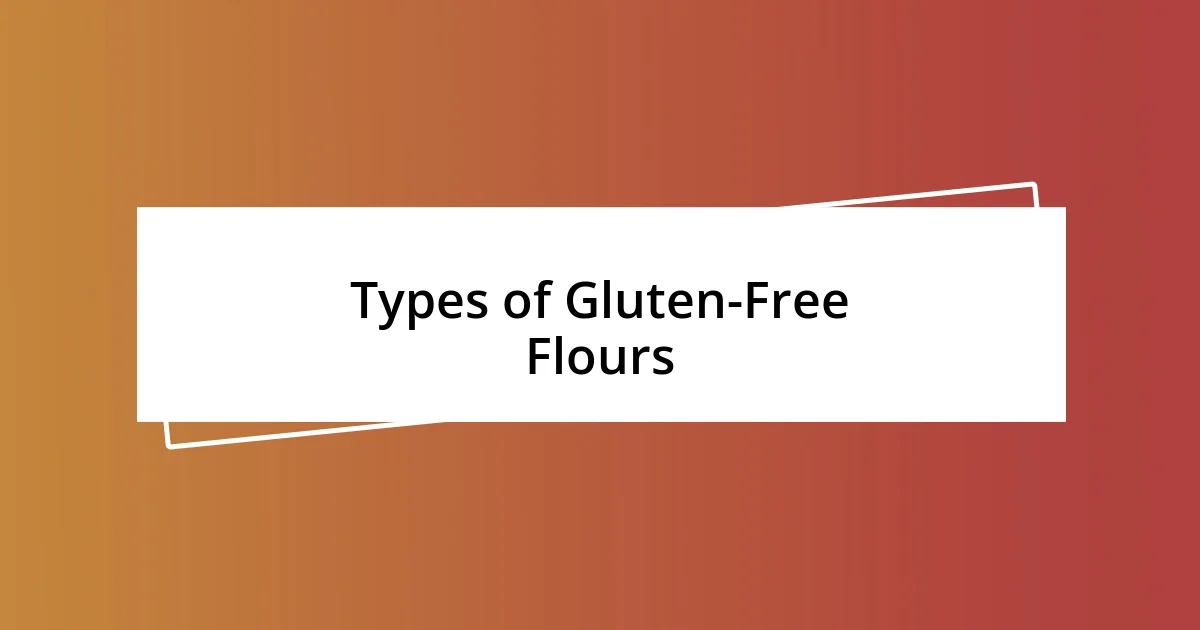Key takeaways:
- Gluten-free cookies can be delicious and satisfying, challenging the stereotype of being dry or crumbly.
- Choosing gluten-free options often stems from health benefits, culinary exploration, and dietary preferences.
- Key baking tips include using binding agents, chilling dough, and ensuring proper moisture for optimal cookie texture.

Introduction to Gluten-Free Cookies
Gluten-free cookies have surged in popularity, especially among those with gluten sensitivities or celiac disease. I’ll never forget the first time I tried one—I was skeptical, expecting a dry, crumbly disaster. To my surprise, it was chewy and delicious, sparking a newfound curiosity for gluten-free baking.
The world of gluten-free baking opens up a spectrum of flavors and textures that you might not expect. Have you ever wondered how something as simple as a cookie could have so many variations? From almond flour to oats, the ingredients create a whole new culinary adventure. Each time I experiment, I’m reminded of how foods can bring joy and comfort, even without gluten.
While gluten-free cookies were once viewed as niche or an afterthought, they’ve now carved out their place in mainstream baking. I remember my friends gathering around, eagerly tasting my latest batch. Their enthusiastic responses reassured me that enjoying treats free from gluten could be just as satisfying—if not more so—than traditional cookies.

Reasons for Choosing Gluten-Free
Choosing gluten-free isn’t just a trend; it’s often a necessity for many. Personally, I’ve seen friends struggle with digestive issues that vanished once they eliminated gluten from their diets. It’s compelling to witness how making this change can improve their overall well-being. For others, it’s a lifestyle choice—an experiment in exploring new flavors and ingredients that they might not have considered before.
Here are some reasons people opt for gluten-free options:
- Health benefits: Alleviates symptoms for those with celiac disease or gluten sensitivities.
- Increased energy: Some have reported feeling more energetic after cutting out gluten.
- Culinary exploration: Trying different gluten-free flours can lead to exciting new baking experiences.
- Digestive comfort: Many find that gluten-free options lead to fewer digestive issues and discomfort.
- Dietary preferences: A growing number of individuals choose gluten-free as part of a holistic approach to health and wellness.

Types of Gluten-Free Flours
Exploring different types of gluten-free flours has been an enlightening experience for me. I remember the first time I used almond flour; it transformed my gluten-free cookies into little bites of nutty goodness. Each flour has its unique characteristics—for instance, chickpea flour is wonderfully dense and adds a hearty flavor, while coconut flour is light and absorbs moisture, making it a fun challenge to work with.
Another flour that captured my interest is brown rice flour. It’s incredibly versatile and offers a subtle taste that doesn’t overpower other ingredients. I often like to mix flours to create the perfect blend for my cookies. By combining almond and coconut flour, I achieve a chewy texture that keeps everyone guessing—what’s the secret ingredient?
The world of gluten-free flours is vast, as each type brings its own flair to baking. I often find joy in experimenting with different combinations and observing how the flavors meld. Recently, I made a batch using a blend of oat and tapioca flour, and the result was a delightful cookie that had just the right amount of crispness. It’s moments like this that deepen my appreciation for the gluten-free baking journey.
| Type of Flour | Characteristics |
|---|---|
| Almond Flour | Nutrient-rich, adds a nutty flavor |
| Coconut Flour | Light, absorbs moisture, creates a dense texture |
| Brown Rice Flour | Versatile, provides a mild taste |
| Chickpea Flour | Dense, hearty flavor, high in protein |
| Oat Flour | Soft texture, mildly sweet, adds chewiness |
| Tapioca Flour | Starch-based, enhances chewiness and crispness |

My Favorite Gluten-Free Recipes
When it comes to baking gluten-free cookies, my absolute go-to recipe features almond flour and dark chocolate chunks. The first time I made these, I was taken aback by how the nutty flavor paired perfectly with the rich chocolate. I can still remember biting into that warm cookie — it felt like a cozy hug on a chilly evening. Have you ever tasted chocolate chip cookies that made you question why you ever worried about going gluten-free? That’s how good these are!
Another gem in my collection is a recipe that incorporates coconut flour paired with mashed bananas. Initially, I was skeptical about how the texture would turn out, but after the first bite, I was hooked. The bananas add a natural sweetness, and if you sprinkle a bit of cinnamon on top, it elevates the flavors to a whole new level. Honestly, every time I share these cookies with friends, they always ask for the recipe. It’s rewarding to show them that gluten-free doesn’t mean sacrificing flavor.
Recently, I experimented with a recipe that fuses chickpea flour with a hint of vanilla extract. The first batch was a bit dense, but oh, the flavor was divine! By adjusting the moisture levels, I created a lighter texture that surprised even me. Isn’t it thrilling when a baking experiment turns out better than expected? I often find the most delightful surprises come from those moments of culinary curiosity.

Tips for Baking Gluten-Free Cookies
When baking gluten-free cookies, one of my top tips is to add a binding agent like xanthan gum or chia seeds. The first time I tried using chia seeds, I was amazed at how they created a gooey texture that helped hold everything together. Have you ever felt like your cookies crumbled into a sad little pile? I know I have, and switching to a better binding agent changed everything for me.
Another little secret I’ve discovered is the importance of chilling the dough before baking. I remember the first time I skipped this step; my cookies spread out like pancakes. By chilling the dough for at least 30 minutes, I found that my cookies maintained their shape beautifully. This simple step not only helps with texture but also enhances the flavors, making each bite explode with deliciousness.
Lastly, don’t shy away from adding moisture! Gluten-free flours can be quite thirsty, but ingredients like nut butters or applesauce work wonders. I once made a mistake by not adding enough moisture, and the cookies came out dry and crumbly—definitely not the treat I had in mind. Now, I always make sure to balance it out. What about you? Have you ever tried adding an unexpected ingredient and been pleasantly surprised by the result? That’s the joy of baking gluten-free!

Common Mistakes to Avoid
One common mistake I’ve made is not measuring gluten-free flours correctly. The first time I followed a recipe, I slightly overmeasured the almond flour. The result? Dense, overly dry cookies that felt more like hockey pucks than delicious treats. Have you ever had that moment of realization while biting into a cookie that just didn’t deliver? It’s a letdown! Trust me; investing in a kitchen scale will change your baking game.
Another pitfall I’ve encountered is underestimating the importance of flavor balance. I remember adding a hefty sprinkle of salt, thinking it would elevate the cookie. Instead, it ended up overpowering the sweetness, turning what could have been a delightful dessert into something less enjoyable. It’s a classic case of “too much of a good thing.” Have you been there? Finding that perfect balance is key to achieving cookie bliss.
It’s easy to overlook oven temperature, but that can completely ruin your batch. I’ve baked cookies that veered between golden perfection and burnt edges simply because I didn’t let my oven preheat adequately. I can still recall the smoky scent that filled my kitchen on that fateful day. Lesson learned: always use an oven thermometer to ensure your baked goods are treated right!

Conclusion and Final Thoughts
When reflecting on my journey with gluten-free cookies, I can’t help but marvel at how much I’ve learned. Each batch—successful or not—has taught me something invaluable about alternative baking. Isn’t it fascinating how a seemingly small tweak can lead to such delicious outcomes?
Ultimately, I believe that baking gluten-free cookies is a satisfying, albeit sometimes challenging, adventure. It goes beyond just following a recipe; it’s about experimentation and customization to suit your taste. The joy I feel when biting into a warm, chewy cookie that I’ve perfected is truly rewarding. Have you found that same thrill in your gluten-free baking journey?
In the end, gluten-free baking has enriched my culinary experiences, encouraging me to think outside the box and embrace new ingredients. I remember the delight in surprising friends with cookies that didn’t make them miss gluten at all. It’s moments like these that reinforce my belief: every challenge faced in the kitchen ultimately leads to more flavorful rewards.














